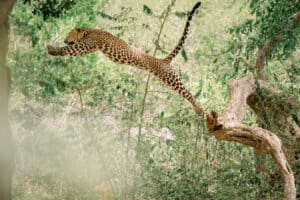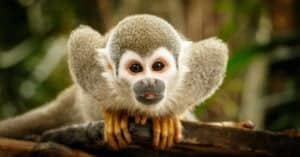We often see monkeys eating fruit from trees, most commonly bananas. However, since many also eat some form of animal protein, they are generally omnivores, not herbivores. And different species of monkeys live in different habitats, so they don’t all have access to the same food sources. Here are some things about monkeys that you might find interesting:
- Monkeys are the only primates with tails, other primates do not have tails.
- They are social animals and use physical grooming to create and maintain relationships.
- Just like humans monkeys also have fingerprints.
- Compared to apes, monkeys have smaller brain capacity and are more primitive in their behavior.
- There are no monkeys living in Antarctica.
- Barbary macaques are the only species of monkey found in Europe.
Read on to learn more about what monkeys eat, where they find their food, why they eat what they do, and more.
What Do Monkeys Eat?
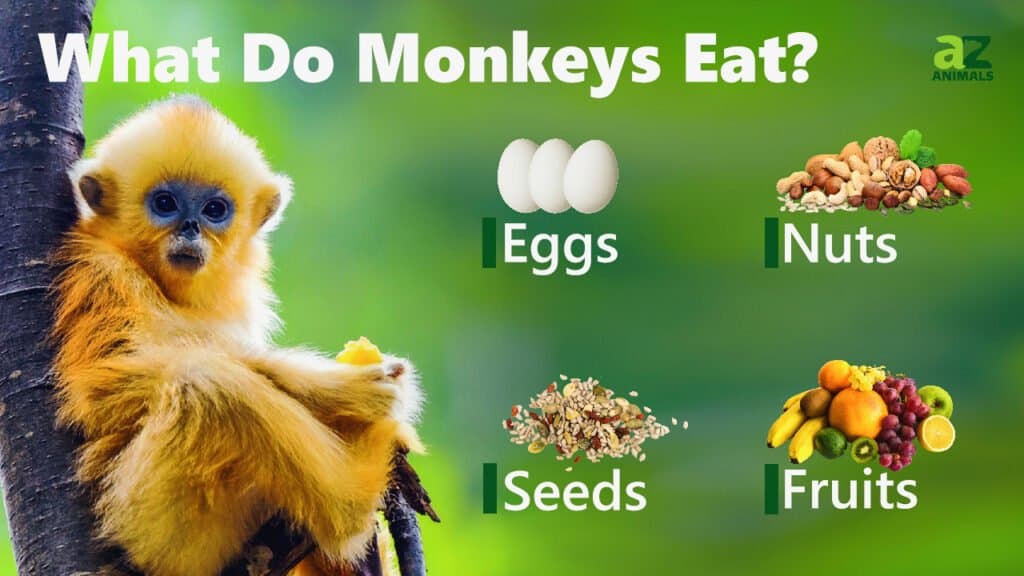
Monkeys are omnivores that eat a varied diet that can include nuts, fruits, seeds, eggs, insects, lizards, and more. With more than 300 species of monkeys and vast differences between Old World (Africa and Asia) and New World (the Americas) monkey species, their diets have adapted to foods that are available locally.
Monkeys are mammals of the order of Primates. They are members of the suborder Hapolorini and the infraorder Simiiformes, the simians. Unlike those in the suborder Strepsirrhini, they cannot synthesize vitamin C and so need it in their diet. For this reason, they exploit a variety of food sources to eat, including bananas and other fruit, which makes them frugivores. Not only are most monkeys generally omnivores, but some species are both frugivorous and insectivorous, and others are primarily either frugivorous or insectivorous. The only obligate carnivorous primate is the tarsier.
Some types of primates have specialized anatomy for exploiting certain foods, including leaves, fruit, gum, or insects. Howler monkeys, for example, are leaf eaters with long digestive tracts for absorbing hard-to-digest leaf nutrients, as are colobus monkeys. Both also have multi-chambered stomachs which allow for specialized fermentation of plant matter, similar to those of ruminants. Capuchin monkeys eat both plant matter as well as insects and other small animals. The gelada is the only Old World monkey species, and, the only primate, whose primary diet is grass, making it an herbivore.
With all the eating of fruits that monkeys do, they are bound to come across overripe fruits. And they do, often. Drunken monkeys have been observed after eating a large amount of sweet-smelling, fermented fruit. But don’t worry, the amount of alcohol they get is relatively low-level. Because they’re getting the alcohol naturally fermented from fruit instead of separating it into its drink, they become full and stop consuming.
What about engaging in acts of cannibalism? This behavior, which is rare among monkeys compared to other primates, can happen for one of a few reasons: A pregnant female wanting the nutrients or a juvenile who’s been recently weaned are a couple of possibilities.
A Complete List of Foods Monkeys Eat
What wild monkeys eat:
- Frugivore and omnivore species: Bananas, mangoes, frleshy fruits like berries, pomes, and drupes, and other fruit
- Frugivore and omnivore species: Grass, leaves, flowers, buds, seeds, gum, nectar
- Insectivore, omnivore, and obligate carnivore species: Insects, snails, and other invertebrates
- Omnivores and obligate carnivore species: Bird eggs, birds, lizards, bats, squirrels, and other small vertebrates
What city monkeys eat:
- Fruit from trees
- Food from humans
- Discarded food in trash
Are Monkeys Omnivores
Yes, monkeys are omnivores and can eat both plants and animals. However, it’s important to note that the majority of most monkey species have diets that tilt heavily toward plant matter. For instance, many New World monkeys have diets that are about 95% plant and 5% invertebrates like insects or nails.
Chimpanzees have a similar diet, for example. Meat and animal products account for 6% of their caloric intake while invertebrates are 4%. Plant matter constitutes the remaining 90% of their diet. Gorillas are even more tilted to calories from plants and only supplement their plant diet with a small amount of invertebrates like ants, termites, and grubs.
This is to say, a diet that’s omnivorous but heavily tilted to plants is common among primates!
Do Monkeys Eat Bananas?
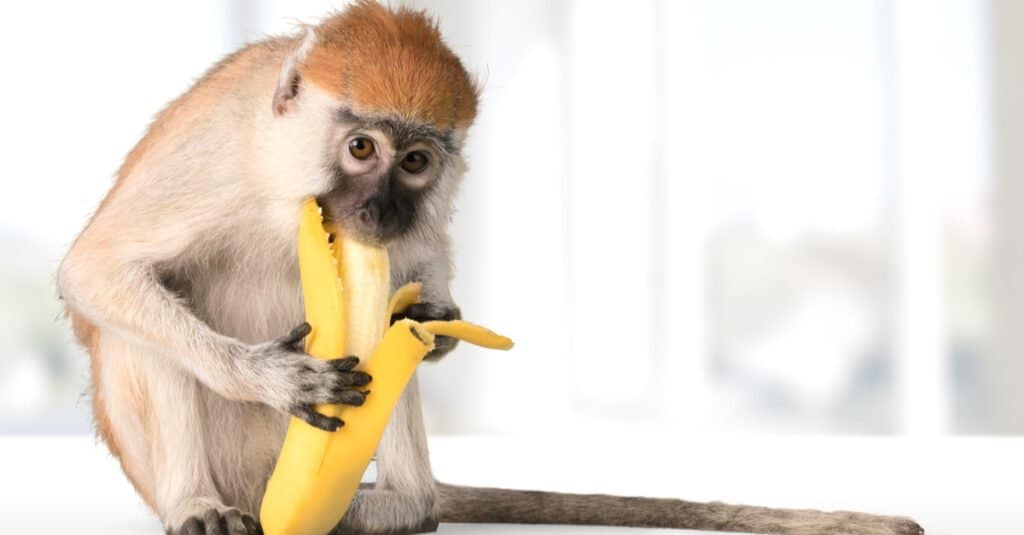
Monkeys eat the same type of bananas as people, but it’s mostly in cpativity.
©Billion Photos/Shutterstock.com
Monkeys in pop culture are often seen as banana-loving primates. That picture comes from cartoon characters like Curious George. However, do monkeys truly love bananas?
The short answer is that monkeys will eat bananas, but it’s generally in zoos. In the wild, bananas are not a primary source of food for monkeys. A study of woolly monkeys in Colombia (a New World species) found that 78.9% of their diet consisted of fleshy fruits. Fruits in Colombia include passion fruit, golden berries, dragon fruits, mangosteen, and citrus fruits.
So while you may see a monkey eating the same type of bananas people eat in captivity, the bananas humans eat are actually a man-made creation. They’re the hybrid of several types of banana species and have a sweeter flavor than wild types of bananas that can be found in the topics. As such, only monkeys near planting sites would eat them.
Where do monkeys find their food?
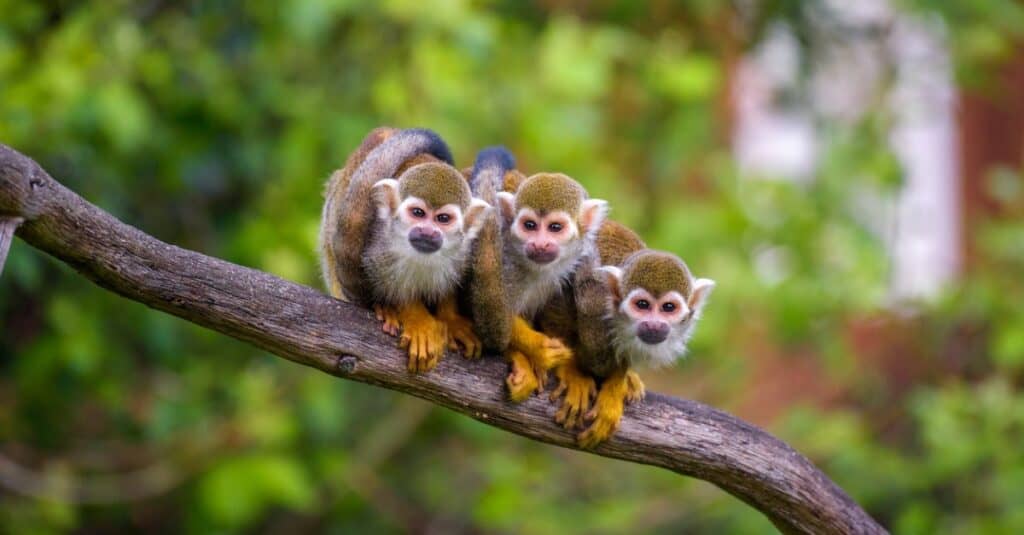
Monkeys travel a lot for their daily diet.
©iStock.com/miroslav_1
Monkeys exploit food sources they can eat and digest from their surrounding habitat. Their food is anything that is relatively easy for them to reach to give them quick fruit sugar, carbohydrates, fiber, and animal protein. Apes and Old World monkeys have opposable thumbs, which helps them to grasp and pluck the fruit as well as the smaller ones to swing from tree to tree. They can also forage on the ground better.
Monkeys travel a lot for their daily diet, and Old World Monkeys have special cheek pouches to store food. Some species store food in caches. Those who eat insects and other small animals such as lizards, snails, and frogs go hunting for them. Capuchin monkeys are New World monkeys that are very intelligent and have been observed using rocks and tools to get at hard shell nuts, ants, termites, and other hard-to-get food.
The urban monkey diet
In India, monkeys are revered as manifestations of the Hindu god Hanuman. Therefore, they are given food out of respect and fear of being attacked. They have become very bold and rebellious around humans there, leaping, exploring, socializing, and fighting among the rooftops, and hanging around temples. Colombia has tamarin monkeys living in cities. In Jigokudani, Japan there are Japanese macaques. They are unique for being able to live in extreme cold and enjoy the hot springs there, and so are called Snow Monkeys.
Urban monkeys, however, are unhealthy as a result of their city-slicking diets. They have less muscle than their wild counterparts, they’re overweight, and have high blood pressure and cholesterol. It’s not only the plentiful fruit trees in the urban forest patches but the junk food they are fed by humans, plus the easy life which means they don’t have to jump around to look for food. Any sugary processed food the humans give them makes them worse in their behavior, becoming hyperactive, highly aggressive, and guaranteed to attack.
What foods are bad, toxic or poisonous for monkeys?
There are various theories doing the rounds as to what food could harm monkeys. Many nutrition experts are now claiming that eating too much banana can be harmful to monkeys as they are high in sugar and can cause diabetes in monkeys.
Devil’s Trumpet or Angel’s Trumpet is poisonous to animals, including monkeys. Pesticides including Organophosphate are toxic to animals, while the organochlorine DDT is not acutely toxic but affects fertility.
Also, eating human food that are created through fermentation, such as bread, cheese, yogurt etc. could harm the gut health of monkeys. It is also being said that feeding wild monkeys regularly is making them more dependent on humans and that is causing them to cease normally looking for food in habitat. This could be harmful in a ecological manner and change their physiology in the long run.
Next Up
- What Do Flamingos Eat? Animals have different eating habits, find out here what flamingos like to eat.
- Food Chain vs Food Web: What’s the Difference?: As long as we are talking about food, read this to find out a more complex idea about food.
- 10 Incredible Monkey Facts: Interested in monkeys? Find out more amusing facts about monkeys.
The photo featured at the top of this post is © Ludmila Ruzickova/Shutterstock.com
Thank you for reading! Have some feedback for us? Contact the AZ Animals editorial team.




